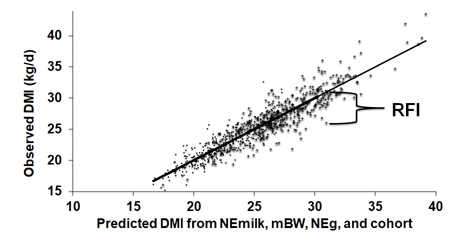
Feed represents the single largest expense on most dairy farms, and even small improvements can have important financial, environmental, and land use implications. We have made tremendous and well-documented gains in the efficiency of milk production over the past half-century through advances in animal breeding, plant breeding, ruminant nutrition, agricultural engineering, and veterinary medicine. Genetic improvements in efficiency have come through increases in milk yield and milk components – these were accompanied by large increases in feed consumption, in order to meet the greater energy demands of lactation. Increasing the proportion of dry matter intake (DMI) used for lactation, relative to DMI used for maintaining bodily functions in a non-lactating state, leads to a phenomenon known as dilution of maintenance.
The swine and poultry industries have been selecting animals for improved feed conversion efficiency for many years and, in most cases, selection has focused on increasing the ratio of body weight gained to feed consumed. Meanwhile, their counterparts in the beef industry have tended to focus on residual feed intake (RFI), which is the difference between actual and expected DMI consumed by an individual animal on a given day. Selection criteria are fairly simple in a feedlot setting, because one can focus exclusively on one energy sink, or bodily function for which consumed DMI is used; in this case it is the accumulation of body tissue, which is typically measured as average daily gain. The situation is much more complicated in dairy cattle, because cows must produce large volumes of milk, accumulate or mobilize body tissue at various stages of the lactation, and maintain important bodily functions associated with remaining healthy, becoming pregnant, and producing a live calf. For this reason, we typically focus on three energy sinks when computing expected DMI and comparing the relative efficiency of dairy cows: energy required for lactation, energy required for maintenance, and energy required for body weight change (growth or added body condition), as shown in the figure below.
Illustration of residual feed intake (RFI) of first (•) and later (+) lactation Holstein cows in U.S. research herds, where RFI represents the difference between observed dry matter intake (DMI) and expected DMI, and the latter is derived from net energy of secreted milk (NEmilk), metabolic body weight (mBW), and net energy of body weight gain (NEg) on a within-cohort basis.
Excellent studies on the genetics of feed efficiency in dairy cattle were published more than 25 years ago, primarily based on work in Europe, but prior to advent of genomic selection it was simply impossible to measure daily DMI on tens of thousands of daughters of new dairy bulls graduating from progeny testing programs each year. The challenge remains daunting in the genomic era, but with significant investments of time, money, labor, and technology we can now measure DMI and RFI in a genomic reference population comprised of cows on university research farms, and the resulting information can be used to compute predicted transmitting abilities (PTAs) for feed efficiency of other cows, bulls, heifers, and calves in the national population.
Research on genomics and feed efficiency in U.S. dairy cattle was jump-started by a USDA-NIFA Agriculture and Food Research Initiative grant led by our Michigan State colleague, Mike VandeHaar, nearly a decade ago. Subsequent investments by the Council on Dairy Cattle Breeding (CDCB) and the Foundation for Food and Agriculture Research have allowed growth of our genomic reference population to more than 6,200 cows at present, with 50 to 75 new cows added each month from research herds in Wisconsin, Michigan, Maryland, Iowa, and Florida. These cows have genomic test results, as well as daily records for milk yield, milk composition, body weight, body condition score (BCS), and DMI for approximately 42 days in mid lactation. We chose the time period between 50 and 200 days postpartum, because that’s when cows are in peak lactation, and when their body weights and BCS are relatively stable. We can compute the RFI of each cow from these data, by comparing her actual DMI with the expected DMI of a cow of equivalent body weight, milk yield, milk composition, and gain or loss in body weight over the study period. All calculations are done within a cohort, where a cohort is defined as all cows housed at a particular research station at given time who are eating the same diet – this is the same concept as the contemporary groups or herdmate deviations we’ve used in routine genetic evaluations of other key traits for decades.
For publication purposes, CDCB will combine PTA values for RFI and BWC into a new trait called Feed Saved. We followed the pioneering research of Jennie Pryce and her colleagues in Australia, and we expect Feed Saved to assist farmers in breeding cows of moderate size that can convert consumed feed into milk and body tissue very efficiently. Said another way, it will help farmers avoid breeding cows that waste feed in achieving and maintaining excessive body size or waste too much consumed energy as feces, gas, urine, and heat. Mathematically, the formula for Feed Saved puts weights of -138 on PTAs for BWC and -1 on PTAs for RFI; because both weights are negative, larger values of Feed Saved are desirable.
Introduction of routine CDCB genomic evaluations for Feed Saved is a big step forward, and the result of nearly a decade of university research. Our work is not finished, though. Beyond adding roughly 750 new cows to the genomic reference population each year, we are collaborating with international partners who can contribute cows to a larger global reference population, developing proxies to predict DMI from inline milk analysis systems, wearable sensors, and computer vision algorithms, and carrying out intensive nutrition and physiology studies that will advance our understanding of key energy sinks and their relationships with dairy cow health, fertility, and feed efficiency.




Leave a Reply